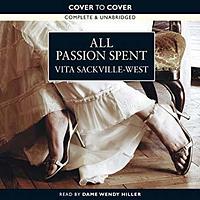Take a photo of a barcode or cover
4.5 ★★★★
Reseña en español | Review in English (below)
”Henry Lyulph Holland, primer conde de Slane, llevaba existiendo tanto tiempo que el público había empezado a considerarle inmortal (…)” así empieza esta obra maestra con la que he descubierto, finalmente, la prosa de [a:Vita Sackville-West|3904620|Vita Sackville-West|https://images.gr-assets.com/authors/1417920269p2/3904620.jpg]. Mi pequeña obsesión con Vita se remonta a abril del año pasado (2017), cuando conocí su historia de amor con Virginia Woolf gracias a [b:A Virginia le gustaba Vita|32060284|A Virginia le gustaba Vita|Pilar Bellver|https://i.gr-assets.com/images/S/compressed.photo.goodreads.com/books/1474042698l/32060284._SX50_.jpg|52702767] y, después, cuando leí sobre su matrimonio con Harold Nicolson (os vuelvo a recomendar desde aquí [b:Retrato de un matrimonio|18455336|Retrato de un matrimonio|Nigel Nicolson|https://i.gr-assets.com/images/S/compressed.photo.goodreads.com/books/1378245842l/18455336._SY75_.jpg|2272194]). Desde entonces llevaba queriendo leer alguna de sus novelas –he leído algunos poemas sueltos en inglés gracias a la todopoderosa Internet–, y conseguí esta edición española de segunda mano cuando ya había dejado de buscar algunas ediciones en inglés.
Es, como dice la propia Vita en la dedicatoria, una historia de personas mayores donde los temas principales sobre el paso del tiempo, la muerte, los deseos no cumplidos, quedan patentes a través no solamente de la protagonista de la historia, Lady Slane, una dama inglesa de más de ochenta años que acaba de perder a su marido, sino también del resto de los personajes: los seis hijos del matrimonio (especialmente Edith y Kay), la doncella francesa Genoux, el casero Mister Bucktrout, el excéntrico coleccionista y millonario Mister FitzGeorge…
Toda la novela se desarrolla a través de la primera persona de esos diferentes personajes y tiene, como argumento principal, que Lady Slane quiere pasar sus últimos días como a ella le plazca, es decir, vivir al fin su vida. Aunque sus hijos planean para ella unos últimos años de comodidades y deben, como así dicta la sociedad, hacerse cargo de su madre, Lady Slane decide alquilar una pequeña casa en Hampstead donde estarán prohibidas las visitas de familiares (y especialmente la de sus nietos y bisnietos) y donde quiere recuperar sus deseos y pasiones que nunca llegó a cumplir debido a las convenciones de un matrimonio victoriano que no la hizo feliz.
A través de la prosa de Vita (irónica, sarcástica, divertida) leeremos sobre la sociedad victoriana y la sociedad inglesa en general –Vita crea una historia universal y atemporal con una novela ambientada hacia 1930–, y nos reiremos, y empatizaremos con los personajes, y descubriremos que quizás la vida de Vita y Lady Slane han tenido algunos puntos en común y que ambas llegaron a soñar con travestirse de chico, cortarse los rizos, y huir para conseguir sus deseos.
Novela recomendadísima de principio a fin. Planeo relectura en inglés tarde o temprano.
– –
"Henry Lyulph Holland, first Earl of Slane, had existed for so long that the public had begun to regard him as immortal (…)” thus begins this masterpiece with which I’ve finally discovered the writing style of [a:Vita Sackville-West|3904620|Vita Sackville-West|https://images.gr-assets.com/authors/1417920269p2/3904620.jpg]. My little obsession with Vita goes back to April of last year (2017), when I found her love story with Virginia Woolf thanks to the Spanish book [b:A Virginia le gustaba Vita|32060284|A Virginia le gustaba Vita|Pilar Bellver|https://i.gr-assets.com/images/S/compressed.photo.goodreads.com/books/1474042698l/32060284._SX50_.jpg|52702767] (Virginia liked Vita) and, later, when I read about her marriage to Harold Nicolson (I have to recommend again [b:Portrait of a Marriage: Vita Sackville-West and Harold Nicolson|102645|Portrait of a Marriage Vita Sackville-West and Harold Nicolson|Nigel Nicolson|https://i.gr-assets.com/images/S/compressed.photo.goodreads.com/books/1328872414l/102645._SY75_.jpg|2272194]). Since then I've been eager to read some of her novels –I’ve read a few poems thanks to the almighty Internet–, and I finally got this second-hand Spanish translation when I had stopped looking around for some editions in English.
This novel is, as Vita herself says in the dedication, a story of people who are old where the main themes about time, death, unfulfilled wishes, are evident not only through the main character of the story, Lady Slane, an English lady over eighty who has just lost her husband, but also through the rest of the characters: her six children (especially Edith and Kay), the French maid Genoux, the landlord Mr Bucktrout, the eccentric collector and millionaire Mr FitzGeorge…
The whole novel is developed through the first person POV of these different characters and has, as a main argument, that Lady Slane wants to spend her last days as she pleases, that is, live at last her life. Although her children plan for her having last years of comfort and must, as society dictates, take charge of her mother, Lady Slane decides to rent a small house in Hampstead where family visits will be forbidden (and especially that of her grandchildren and great-grandchildren) and where she wants to recover her desires and passions never fulfil due to the conventions of a Victorian marriage that didn’t make her happy.
Through Vita’s writing style (ironic, sarcastic, funny) we will read about Victorian society and English society in general –Vita was able to create a universal and timeless story with a novel set around 1930–, and we will laugh, and empathize with the characters, and we will discover that perhaps the lives of Vita and Lady Slane have had some points in common and that both of them came to dream of transvesting as a boy, cutting their curls, and fleeing to get their wishes.
Totally worth it from beginning to end. Planning on rereading in English sooner or later.
P. S. I'm not English, so if you see any mistakes let me know so I can correct them, please
«En síntesis, Deborah, a la edad de diecisiete años, había decidido convertirse en pintora»
Reseña en español | Review in English (below)
”Henry Lyulph Holland, primer conde de Slane, llevaba existiendo tanto tiempo que el público había empezado a considerarle inmortal (…)” así empieza esta obra maestra con la que he descubierto, finalmente, la prosa de [a:Vita Sackville-West|3904620|Vita Sackville-West|https://images.gr-assets.com/authors/1417920269p2/3904620.jpg]. Mi pequeña obsesión con Vita se remonta a abril del año pasado (2017), cuando conocí su historia de amor con Virginia Woolf gracias a [b:A Virginia le gustaba Vita|32060284|A Virginia le gustaba Vita|Pilar Bellver|https://i.gr-assets.com/images/S/compressed.photo.goodreads.com/books/1474042698l/32060284._SX50_.jpg|52702767] y, después, cuando leí sobre su matrimonio con Harold Nicolson (os vuelvo a recomendar desde aquí [b:Retrato de un matrimonio|18455336|Retrato de un matrimonio|Nigel Nicolson|https://i.gr-assets.com/images/S/compressed.photo.goodreads.com/books/1378245842l/18455336._SY75_.jpg|2272194]). Desde entonces llevaba queriendo leer alguna de sus novelas –he leído algunos poemas sueltos en inglés gracias a la todopoderosa Internet–, y conseguí esta edición española de segunda mano cuando ya había dejado de buscar algunas ediciones en inglés.
Es, como dice la propia Vita en la dedicatoria, una historia de personas mayores donde los temas principales sobre el paso del tiempo, la muerte, los deseos no cumplidos, quedan patentes a través no solamente de la protagonista de la historia, Lady Slane, una dama inglesa de más de ochenta años que acaba de perder a su marido, sino también del resto de los personajes: los seis hijos del matrimonio (especialmente Edith y Kay), la doncella francesa Genoux, el casero Mister Bucktrout, el excéntrico coleccionista y millonario Mister FitzGeorge…
Toda la novela se desarrolla a través de la primera persona de esos diferentes personajes y tiene, como argumento principal, que Lady Slane quiere pasar sus últimos días como a ella le plazca, es decir, vivir al fin su vida. Aunque sus hijos planean para ella unos últimos años de comodidades y deben, como así dicta la sociedad, hacerse cargo de su madre, Lady Slane decide alquilar una pequeña casa en Hampstead donde estarán prohibidas las visitas de familiares (y especialmente la de sus nietos y bisnietos) y donde quiere recuperar sus deseos y pasiones que nunca llegó a cumplir debido a las convenciones de un matrimonio victoriano que no la hizo feliz.
A través de la prosa de Vita (irónica, sarcástica, divertida) leeremos sobre la sociedad victoriana y la sociedad inglesa en general –Vita crea una historia universal y atemporal con una novela ambientada hacia 1930–, y nos reiremos, y empatizaremos con los personajes, y descubriremos que quizás la vida de Vita y Lady Slane han tenido algunos puntos en común y que ambas llegaron a soñar con travestirse de chico, cortarse los rizos, y huir para conseguir sus deseos.
Novela recomendadísima de principio a fin. Planeo relectura en inglés tarde o temprano.
«Pero uno era feliz en un momento, desgraciado dos minutos más tarde, y en ninguno de los dos casos por una razón de peso»
– –
"Henry Lyulph Holland, first Earl of Slane, had existed for so long that the public had begun to regard him as immortal (…)” thus begins this masterpiece with which I’ve finally discovered the writing style of [a:Vita Sackville-West|3904620|Vita Sackville-West|https://images.gr-assets.com/authors/1417920269p2/3904620.jpg]. My little obsession with Vita goes back to April of last year (2017), when I found her love story with Virginia Woolf thanks to the Spanish book [b:A Virginia le gustaba Vita|32060284|A Virginia le gustaba Vita|Pilar Bellver|https://i.gr-assets.com/images/S/compressed.photo.goodreads.com/books/1474042698l/32060284._SX50_.jpg|52702767] (Virginia liked Vita) and, later, when I read about her marriage to Harold Nicolson (I have to recommend again [b:Portrait of a Marriage: Vita Sackville-West and Harold Nicolson|102645|Portrait of a Marriage Vita Sackville-West and Harold Nicolson|Nigel Nicolson|https://i.gr-assets.com/images/S/compressed.photo.goodreads.com/books/1328872414l/102645._SY75_.jpg|2272194]). Since then I've been eager to read some of her novels –I’ve read a few poems thanks to the almighty Internet–, and I finally got this second-hand Spanish translation when I had stopped looking around for some editions in English.
This novel is, as Vita herself says in the dedication, a story of people who are old where the main themes about time, death, unfulfilled wishes, are evident not only through the main character of the story, Lady Slane, an English lady over eighty who has just lost her husband, but also through the rest of the characters: her six children (especially Edith and Kay), the French maid Genoux, the landlord Mr Bucktrout, the eccentric collector and millionaire Mr FitzGeorge…
The whole novel is developed through the first person POV of these different characters and has, as a main argument, that Lady Slane wants to spend her last days as she pleases, that is, live at last her life. Although her children plan for her having last years of comfort and must, as society dictates, take charge of her mother, Lady Slane decides to rent a small house in Hampstead where family visits will be forbidden (and especially that of her grandchildren and great-grandchildren) and where she wants to recover her desires and passions never fulfil due to the conventions of a Victorian marriage that didn’t make her happy.
Through Vita’s writing style (ironic, sarcastic, funny) we will read about Victorian society and English society in general –Vita was able to create a universal and timeless story with a novel set around 1930–, and we will laugh, and empathize with the characters, and we will discover that perhaps the lives of Vita and Lady Slane have had some points in common and that both of them came to dream of transvesting as a boy, cutting their curls, and fleeing to get their wishes.
Totally worth it from beginning to end. Planning on rereading in English sooner or later.
P. S. I'm not English, so if you see any mistakes let me know so I can correct them, please
A wonderful look at a time and place, a family, and aging. Beautifully constructed. Very strong recommend.
inspiring
reflective
fast-paced
Plot or Character Driven:
Character
Strong character development:
Yes
Loveable characters:
Complicated
Diverse cast of characters:
Yes
Flaws of characters a main focus:
No
emotional
reflective
slow-paced
Plot or Character Driven:
Character
Strong character development:
Complicated
Loveable characters:
Yes
Diverse cast of characters:
No
Flaws of characters a main focus:
Yes
Como muchas lectoras, el nombre de Vita llegó a mi a través de Virginia Woolf y el romance que ambas mantuvieron. Que Virginia admirase a Vita como escritora, fue el empujón que necesitaba para comenzar una novela suya. Y qué alegría haberlo hecho.
Toda Pasión Apagada es un relato plano, lineal y de re-descubrimiento de una anciana que se acaba de quedar viuda. Una historia sencilla y que te atrapa, aunque no desde el principio, todo hay que decirlo.
La narrativa de Vita, y coincido con muchas reseñas de sus obras, tiene algo especial que te sumerge incluso en la historia más lejana a ti. Leyendo esta novela, es comprensible entender por qué fue un éxito en su época: no es tradicional, se sale de los estándares y si bien no creo que sea correcto hablar de feminismo, teniendo en cuenta las fechas, si que percibo un ligero atisbo, una chispa de liberación de la mujer de los roles que tenían, marcado por supuesto, con un necesario toque de realismo.
Por último, destacar el curioso y llamativo parecido de esta novela con alguna que otra de Virginia, no en la trama sino en la esencia, y es que ya comentó Vita en su momento que Virginia era una fuente de inspiración para ella, incluso antes de conocerla.
@lawellsiana
Toda Pasión Apagada es un relato plano, lineal y de re-descubrimiento de una anciana que se acaba de quedar viuda. Una historia sencilla y que te atrapa, aunque no desde el principio, todo hay que decirlo.
La narrativa de Vita, y coincido con muchas reseñas de sus obras, tiene algo especial que te sumerge incluso en la historia más lejana a ti. Leyendo esta novela, es comprensible entender por qué fue un éxito en su época: no es tradicional, se sale de los estándares y si bien no creo que sea correcto hablar de feminismo, teniendo en cuenta las fechas, si que percibo un ligero atisbo, una chispa de liberación de la mujer de los roles que tenían, marcado por supuesto, con un necesario toque de realismo.
Por último, destacar el curioso y llamativo parecido de esta novela con alguna que otra de Virginia, no en la trama sino en la esencia, y es que ya comentó Vita en su momento que Virginia era una fuente de inspiración para ella, incluso antes de conocerla.
@lawellsiana
adventurous
lighthearted
mysterious
relaxing
medium-paced
Plot or Character Driven:
Character
Strong character development:
No
Loveable characters:
Complicated
Diverse cast of characters:
No
Flaws of characters a main focus:
Complicated
reflective
medium-paced
Plot or Character Driven:
Character
Strong character development:
No
Loveable characters:
Yes
Diverse cast of characters:
No
Flaws of characters a main focus:
Yes
Reflection on society and permissible roles and choices.
reflective
slow-paced
Plot or Character Driven:
Character
Strong character development:
Yes
Diverse cast of characters:
No





